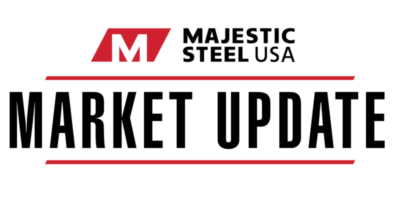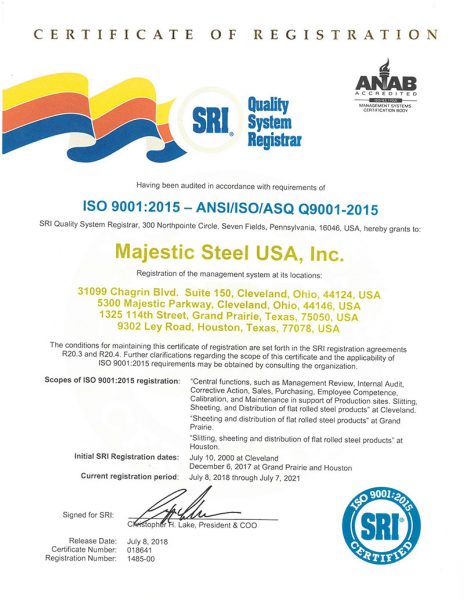Market Update | February 15, 2023
ANOTHER ROUND OF PRICE INCREASES ANNOUNCED
U.S. domestic mills announced another round of increases, pushing pricing up $50/t. This is the fifth round of price increase announcements, totaling roughly $260/t. Most notably, minimum HRC pricing is now at $900/t. All domestic mills that normally publish notices did so this week.
Input Costs
As the recent up and down movement for zinc continues, pricing dropped again this week.
-
-
Zinc pricing came in at $1.40/lb this week, down from $1.42/lb previously and is at its lowest level in over a month.
-
Met coal pricing pushed higher this week, currently trading at $385.00/mt.
-
-
This is up nearly 24.0% over the last month on the back of supply concerns and the threat of a tropical cyclone heading toward Queensland, Australia, mid-week.
- The recent train derailment in Australia, causing at least a ten-day delay, has also helped keep upward pressure on pricing.
-
Supply
U.S. raw steel production climbed once again last week, now up for the fifth consecutive week.
-
- U.S. steelmakers produced 1.664 million tons at an 74.4% utilization rate.
- This was the highest weekly output since the week before Halloween.
- Despite the recent bump higher, YTD production is down 6.4% compared to last year.
Based on preliminary import license data, February imports, through the first 13 days of the month, are up 5.8% compared to the same timeframe in January.
-
- Carbon flat rolled import licenses in February are down 21.4% from the rate in January.
According to the Turkish Steel Producers’ Association (TCUD), steel mills located in the regions impacted by the early February earthquakes could remain idled for about a month despite no major structural damage to facilities.
-
- The main issues impacting those mills currently are issues with workforce, logistics and power.
-
Roughly 30% of Turkey’s steel production comes from this region.
DEMAND
December carbon flat rolled consumption came in at a rate of 127.0 thousand tons/day, down from a 130.3 thousand tons/day rate in November and is well below the 157.5 thousand tons/day rate in December 2021.
-
-
Full year 2022 total carbon flat rolled consumption came in at 51.48 million tons, down 11.5% from the 2021 total and only 4.7% above the total from the pandemic effected 2020 year.
-
Per/day coated flat rolled consumption declined for the fourth consecutive month in December, sliding 3.9% to a 48.9 thousand tons/day rate. December was down 23.9% from the 63.7 thousand tons/day rate in December 2021 and is the lowest daily rate since June 2020
-
For 2022, total coated consumption was 20.16 million tons, down 9.7% from the 22.32 million ton total in 2021.
-
Business activity from the manufacturing sector in the New York region continued to decline in February, but at a much slower rate than in January.
-
-
The February Empire Manufacturing Index came in at -5.8, a 27.0 improvement from the -32.9 reading in January.
- The two-month average came in at -19.4, a slight improvement from the -22.1 two month average in January.
- This was the seventh consecutive month in which the two-month average was below 0.0.
- Any reading over 0.0 indicates expansion, while any reading below 0.0 shows contraction.
- In February, the new order component declined, while the shipments component was virtually flat.
- The new order and shipment components came in at -7.8 and 0.1, respectively.
- The unfilled orders component continued to contract as well, coming in at -9.2.
-
ECONOMIC
Prices paid by consumers continued to push higher in January, just at a slower annual rate than in previous months.
-
-
The January Consumer Price Index increased 0.80% from December and was up 6.41% from January 2022.
-
This is down from the 6.45%, year-over-year, increase in December and the lowest annual increase since October 2021.
- Excluding the volatile food and energy sectors, prices were up 0.62% from December and up 5.58% from January 2022.
- The CORE index was pushed higher by increased prices for shelter, motor insurance, apparel, and furniture.
- Prices for used vehicles, medical care, and airline fares slipped from December.
- The 7.9%, year-over-year, increase for the shelter index accounted for nearly 60% of the total increase in all items less food and energy.
-
After sliding the previous two months, seasonally adjusted retail sales increased in January.
-
-
January retail sales came in at a $697.0 billion rate, up 3.0% from December and up 6.4% from a $655.2 billion rate in January 2022.
- This was the largest month-over-month increase in nearly two years.
- Excluding sales from motor vehicle and parts dealers, sales came in at a $565.5 billion rate, up from a $552.7 billion rate in December.
- The largest increases in sales in January came from auto dealers, furniture stores, electronic stores, and bars/restaurants.
- No kinds of business saw a month-over-month decline and only gas station sales were flat.
-
This material, information and analyses (the “Content”) may include certain statements, estimates and projections prepared with respect to, among other things, historical data and anticipated performance. Content may reflect various assumptions by Majestic Steel USA, Inc. concerning anticipated results that are inherently subject to significant economic, competitive and other uncertainties and contingencies and have been included for illustrative purposes. Content is provided AS-IS.

